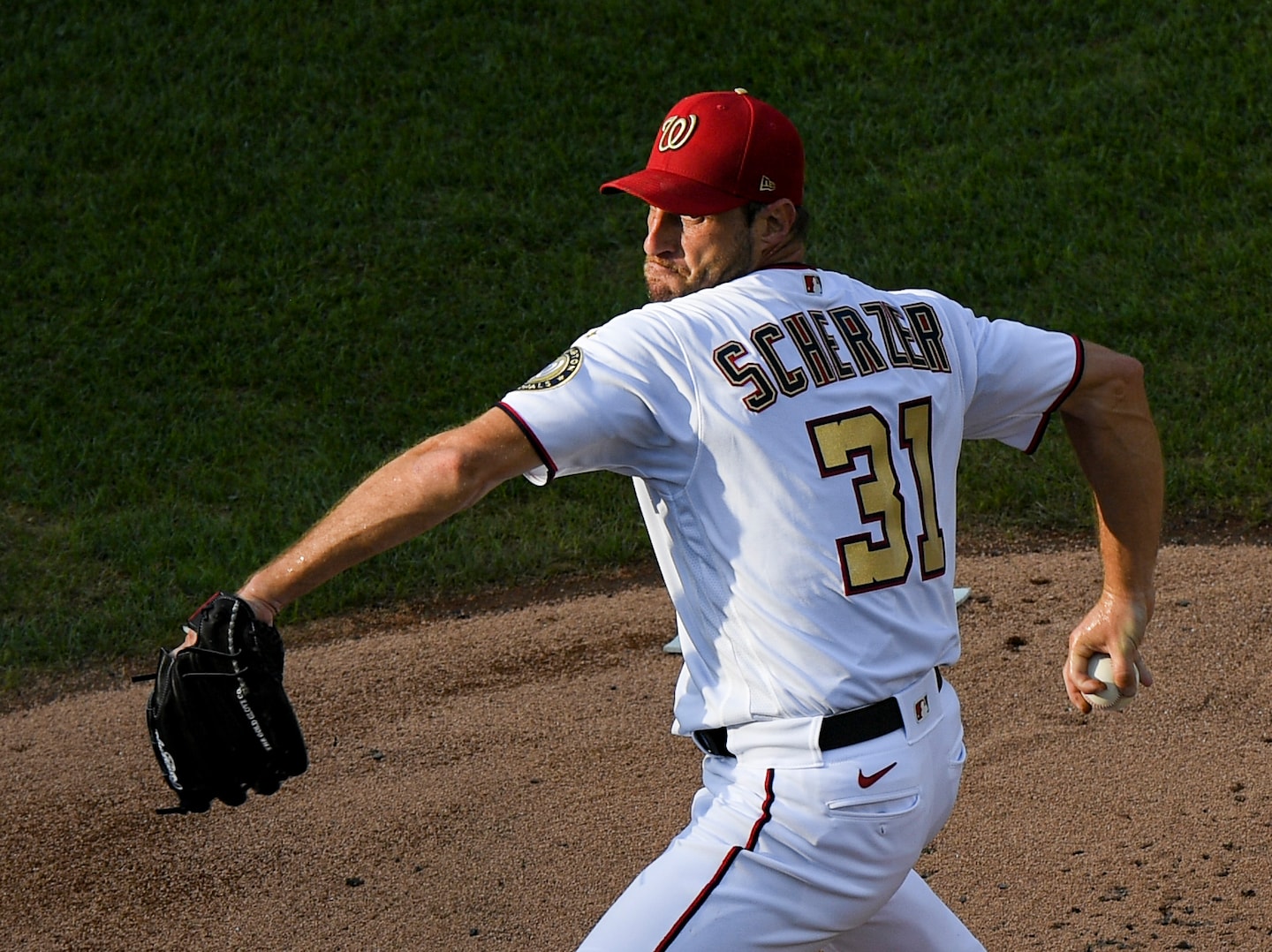Max Scherzer exits early with tweaked hamstring as Nats fall to Mets, 3-1

The Washington Nationals later lost, 3-1, to the New York Mets on Wednesday. Scherzer, though, disappeared around 6:30 p.m., less than 30 minutes after he threw his first pitch, and only resurfaced for a postgame media session. He seemed relaxed and comfortable with his status moving forward. He explained that he first felt hamstring pain while sprinting ahead of his start against the Toronto Blue Jays on July 29. He threw 112 pitches in that outing, recovered well and then tweaked it again, in a slightly different spot, while running Tuesday.
Scherzer called it a “minor injury” that didn’t worsen against the Mets. He doesn’t anticipate missing his next start, and thought he might have had 100 pitches in him Wednesday until his mechanics and command wavered in the first.
Erick Fedde relieved him in the top of the second. From there, the offense couldn’t solve Mets starter Rick Porcello or Seth Lugo out of the bullpen. The Mets (5-8) retired 16 in a row to finish the game, dropping the Nationals to 4-5 on the season.
“That was my limit today,” Scherzer said. “I wasn’t going to push past my limit. It wasn’t going to loosen up any more by pitching.”
“It was good news,” Manager Dave Martinez added of how Scherzer felt after the loss, since, as of Wednesday, there was doubt about whether he’d face the Mets at all. Scherzer says his hamstring felt fine coming out of the Blue Jays start. He was able to lift and do his usual conditioning. But once it flared up again, and made it hard for him to push off his right leg, the Nationals lined up Fedde as a safety option.
As first pitch neared, Fedde and Scherzer warmed side-by-side in the Nationals’ bullpen. Then he was up again in the bottom of the first, as Scherzer paced through the dugout. Scherzer’s hands rested on each hip. He chatted with the medical staff and catcher Kurt Suzuki. He appeared a bit frustrated.
The ace is coming off a 2019 filled with confusing back and shoulder pains. He missed six weeks with an injury that was diagnosed in three different ways across 16 days. He then missed Game 5 of the World Series with neck spasms. His birthday last month, on July 27, was a reminder that time keeps going. So did recently striking out Vladimir Guerrero Jr. about a decade after striking out the 21-year-old’s father.
Yet Scherzer has long pushed against the trappings of age. In his first and only inning Wednesday, his fastball hovered between 92 and 94 mph, a few ticks below his usual speed. He walked leadoff hitter Brandon Nimmo on five pitches. He allowed a single, struck out Pete Alonso, yielded a run on a sacrifice fly, escaped with a groundout, and that was it.
“Zuk just saw what my stuff was playing like, and he didn’t like it,” Scherzer said of his talk with Suzuki after the first. “He didn’t like how the ball was coming out of my hand, what he was seeing, and we just had a conversation: Just get out of here. You’re taking on too much risk to continue to pitch.”
Soto evened the score with an RBI double in the bottom half. Fedde gave up one run in three shaky innings of relief. Porcello was sharp throughout, silencing the Nationals in the second, third, fourth, fifth, sixth and seventh. He finished his start by retiring 10 batters in a row. And in the top of the seventh, with the score still close, Sean Doolittle yielded a run on two hits and a walk.
Heading into this series, the Nationals’ biggest problems were Stephen Strasburg’s nerve irritation and Doolittle’s slow start. But now, heading into an off day, Scherzer becomes a top concern. The Nationals and Scherzer are convinced this hamstring tweak will pass soon. At least. that’s their hope.
“I’m thinking in a couple days I’m going to feel pretty darn good,” Scherzer said. “I really don’t think this is a major injury.”
Scherzer’s hamstring fits into a troubling, leaguewide narrative of pitcher injuries. On Scherzer’s own team, Strasburg remains sidelined and reliever Will Harris is currently on the 10-day injured list with a right groin strain. Braves ace Mike Soroka is out for the season after tearing his right Achilles’ tendon. So is Rangers ace Corey Kluber with a shoulder injury. It’s also possible that neither Houston’s Justin Verlander nor the Angels’ Shohei Ohtani will throw a pitch again in 2020 because of forearm strains.
That list goes on. And while it’s hard to draw a line between any two injuries — let alone two dozen — there is a similarity for pitchers in 2020: They ramped up for a month this spring, then shut down for close to four months, then had to rush back into shape during the three weeks of summer training.
In July, Strasburg described the build up as a “mad dash.” Others used “sprint” or a “real challenge.” Labels aside, a half-year of stops and starts, of throwing into a net instead of a catcher’s mitt, of treating April, May and June like a second offseason, has not been kind to some of baseball’s best arms.
“We’ve got to be really, really careful,” Martinez said of the next steps with Scherzer. “We really do.”






